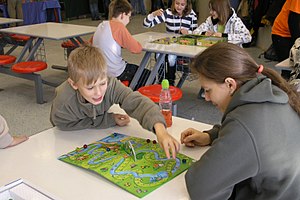Monte Rolla
| Monte Rolla | |
|---|---|

|
|
| Game data | |
| author | Ulrike Gattermayer-Kapp and Manfred Kapp |
| publishing company | Selecta |
| Publishing year | 2003 |
| Art | dice game |
| Teammates | 2 to 4 |
| Duration | 20 minutes |
| Age | from 4 years
|
| Awards | |
The children's game Monte Rolla simulates an off-road race in which river crossings can become an obstacle or acceleration element. Because of the gradient in the board, gravity plays a role. The process is similar to Mensch ärgere dich nicht .
The game developed by Ulrike Gattermayer-Kapp and Manfred Kapp and published by Selecta in 2003 was on the recommendation list for Children's Game of the Year 2004.
Equipment and game board
The game board is given a two-sided slope by a support under the fold . The construction is fixed by the silhouette of a mountain rising from the game board . Three marbles in four colors each serve as pawns, the range of which is determined by a six-sided die .
The mountain towering in the middle of the board has two rivers on both sides, each of which follows one of the two slopes. The rivers are shaped as milled channels. On one half of the board they unite to form a trough designed as a pond . On the other hand, a channel ends in a corner in a sea view. In the last corner, a river widening serves as a starting point. From here a path winds around the mountain to the mouth of the river that ends in the sea. The path crosses the waters several times and even occasionally runs in it. Holes in the path usually only offer space for one marble, but there are also three oval hollows for up to two marbles. Areas designed as stepping stones lying in the river provide little support.
procedure
At the beginning, each player receives two marbles of one color, which should be transported to their destination as quickly as possible. To do this, the player in turn rolls once. If a six is rolled, it can be rolled again and the result is added to the previous total. Then the player moves a marble of his color the corresponding number of steps forward. Every hollow in the path, the stones lying in the river and the eddies located there count as a step.
If the movement ends on a hollow covered with a marble, the other marble rolls down the slope. Depending on the position, this is advantageous for players because they may reach their goal faster. But it can also be disadvantageous because you are catapulted closer to the beginning. Luck plays a big role here.
A marble remains lying on the stepping stones lying in the water without any problems. But if a marble rolls up from above, it pulls down all the marbles resting there. If a move has to be ended on a vortex field, the vortex takes the marble with it and transports it into the valley.
A few fields offer protection because there is room for two marbles. Only when a third marble comes into such a field does one of the other two marbles have to be thrown out. It is the player's turn to decide which one it is.
The player whose two marbles arrive first in the sea wins.
Reviews
It is stated that the board game graphics are colorful and beautiful. However, it is also criticized that the actual route is not easily recognizable in places. As a result, players could often unintentionally cheat. Connecting lines between the individual fields would have been helpful. In addition, it only vaguely describes what has to happen to a marble in the river between start and finish.
There is no marking of the places where marbles from the water can be set back on land.
Web links
- Monte Rolla in the Luding games database
- Monte Rolla in the game database BoardGameGeek (English)
Individual evidence
- ^ Monte Rolla - Game of the Year. In: spiel-des-jahres.de. Retrieved March 27, 2020 .
- ↑ Play test for the game: Monte Rolla. In: ftp.informatik.rwth-aachen.de. Retrieved March 27, 2020 .